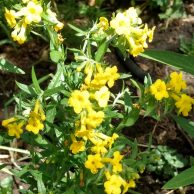 We generally agree that the term “Xeriscape” (water–conserving landscape) applies to plantings watered deeply one a week. However, in July it’s safer to water twice a week. At Harlequin’s Gardens, some of our shrubs and trees are only watered once a month, and twice in July. One of our gardens of mostly native shrubs and trees is never watered.
We generally agree that the term “Xeriscape” (water–conserving landscape) applies to plantings watered deeply one a week. However, in July it’s safer to water twice a week. At Harlequin’s Gardens, some of our shrubs and trees are only watered once a month, and twice in July. One of our gardens of mostly native shrubs and trees is never watered.
What does that mean, “water deeply“? It means that when you irrigate by hand or sprinkler or drip, the soil should be moist to a depth of at least 4″. Moisture meters and the old ‘screwdriver test‘ are not as accurate as digging a small hole 4 to 6” deep and feeling the soil. If it is dry at 4″ just after watering, you will need to water longer.
You can water less frequently if:
1-You have added compost to your soil
2-You have added expanded shale (10-20% by volume) to your soil
3-You have inoculated your plant roots (especially at planting time) with beneficial mycorrhizal fungi 4- you have covered your soil with mulch, or if your plants cover and shade the soil.
Do not:
1-Water lightly every day (except if temperatures exceed 95 degrees); it encourages shallow rooting and evaporates rapidly.
2-Water deeply more than twice a week, creating saturated soil that excludes air (plants and beneficial soil life need air as much as they need water).
3-Plant too close together, creating competition for water. It’s better to mulch the gaps between plants while you wait for them to fill in.
4-Mix plants with high and low water needs in the same planting bed.
When you plant in July:
1-Prepare the soil well, incorporating 30% compost (a 1-2” layer spread on top and then dug in to a depth of 6“)
2-Inoculate the roots of the new plants with mycorrhizae, which will vastly improve transplanting success of most species
3-Treat your new ‘babies‘ as if you’d just brought them home from the hospital, i.e. water them frequently, shield them from hot sun with shade cloth or another source of shade until you see new growth. Then you will know that their roots have reached into the surrounding soil.
4-Place a ‘flag‘ next to every new plant so you can quickly see which plants need the most attention. 5- If your soil is very dense clay (a 10“-deep hole holds water for 30 minutes or longer, add expanded shale (10-20% by volume) along with compost.
6-If you’re leaving town, even for just a few days, give your special watering jobs to someone you would trust with your life.


 On our hikes, it seems we’re often exclaiming, “What a beautiful plant combination!”. Mother Nature’s inherent beauty and functional placement provide an amazing guide and inspiration for what we can create in our home garden or ecosystem. Mother Nature also helps guide us on how we can best support our pollinators.
On our hikes, it seems we’re often exclaiming, “What a beautiful plant combination!”. Mother Nature’s inherent beauty and functional placement provide an amazing guide and inspiration for what we can create in our home garden or ecosystem. Mother Nature also helps guide us on how we can best support our pollinators.